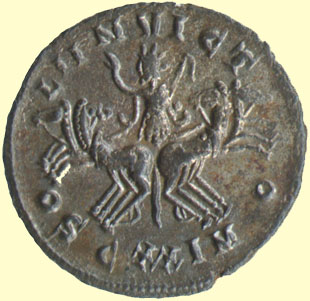 Contents -
Previous Article -
Next Article
Contents -
Previous Article -
Next Article
Sol whips the four horses pulling his chariot into a lather as they charge straight out of the coin at the viewer. This is one of the beautiful medallic reverses seen on coins of the emperor Probus
Pulled by specially bred horses, chariots like the one shown on this coin served the Romans as "mechanized infantry" and provided a fast, reasonably well armored platform for mobile archery strikes. They had been used by much earlier civilizations including the Assyrians, Hittites, and Egyptians who employed them in war and also as a suitably triumphant loking conveyance for their rulers while on parade before their people. Chariots and the horses that pulled them also served as a psychological weapon, striking fear into the hearts of enemy soldiers. Ancient chariots were attached to a type of harness that forced the horse to pull with his neck rather than his shoulder as is the case with modern harness. This was injurious to the horse, often choking the animal and certainly reducing the weight of load he could have pulled had he been fited with a better collar. It has been speculated that the reason so many horses depicted in ancient art are shown in the act of rearing up and pawing the air with their front hooves is that they were reacting against the harness rather than displaying their bellicose fierceness and raw animal power!
The onager, meaning "wild ass" in Latin, was the name given to the small Roman catapult used for hurling medium sized stones at enemy troops and over the walls of fortified towns. Like the ballista and the large siege catapult, the onager was powered by a spring made of a combination of twisted leather thongs and heavy arms made of springy wood or bone layered with wood. The operator would use a pole in a windlass to wind up the onager, which had a ratchet so that the soldier operating it could move the pole to another socket in the windlass. When the trigger mechanism was released, the wound up spring would swing up a long arm at the end of which was a basket holding a good sized stone. The secret of how the Romans were able to make such good springs from hide and bone from animals and wood from trees has been lost. Some historians who have investigated the scientific discoveries of the ancient world believe that the Greeks had developed a springy alloy of bronze unlike the spring bronze used in some machine parts today, but it was only used in experimental catapults. There is no evidence that the Romans utilized metal springs in any of their siege engines.
Go to next article:
Go back to previous article: